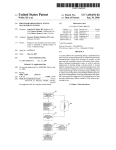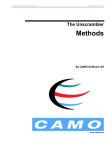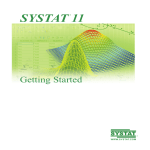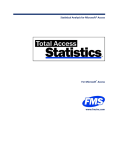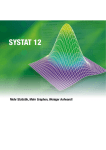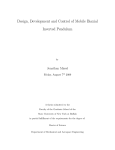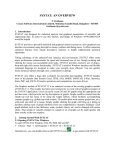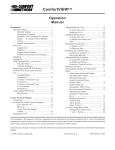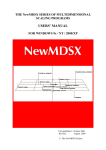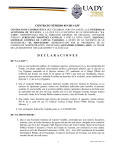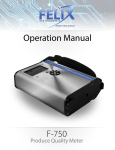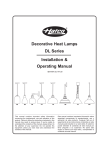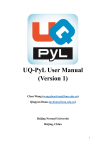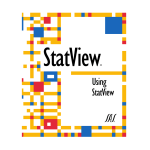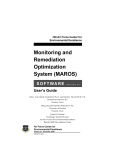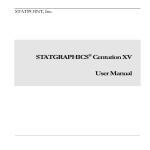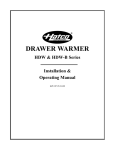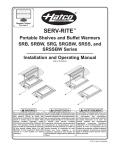Download SYSTAT Features
Transcript
SYSTAT Comprehensive List of Features Statistics (Letters in red color are new features in Version 12 of SYSTAT) Descriptive Statistics • Column o Arithmetic mean, median, sum and number of cases o Min, max, range and variance o Coefficient of variation, std err of mean o Adjustable confidence intervals of mean o Skewness, kurtosis, including standard errors o Shapiro-Wilk normality test o N- & P- Tiles: Cleveland, Weighted average 1, Weighted average 2, Weighted average 3, Closest, Empirical CDF, Empirical CDF (average), o Trimmed, Geometric, and Harmonic means o Stem-and-Leaf display o Resampling– Bootstrap, without replacement, Jackknife o Bootstrap estimates, p-values and confidence intervals for descriptive statistics and correlation regression • Row o Arithmetic mean, median, sum and number of cases o Min, max, range and variance o Coefficient of variation, std err of mean o Adjustable confidence intervals of mean o Skewness, kurtosis, including standard errors o Shapiro-Wilk normality test o N- & P- Tiles: Cleveland, Weighted average 1, Weighted average 2, Weighted average 3, Empirical CDF, Empirical CDF (average), Closest o Trimmed, Geometric, and Harmonic means o Stem-and-Leaf display o Resampling – Bootstrap, without replacement, Jackknife o Bootstrap estimates, p-values and confidence intervals • Multivariate skewness and kurtosis Multivariate normality tests based on skewness and kurtosis; Henze-Zirkler test Probability Distributions • Computes probability density function, cumulative distribution function, inverse cumulative distribution function, and upper-tail probabilities for a wide variety of univariate discrete and continuous probability distributions • Quick Graphs: graphs of the probability density function and the cumulative distribution function for continuous distributions • Random sampling from univariate and multivariate distributions • Fitting (univariate) distributions, Kolmogorov-Smirnov tests, Anderson-Darling tests, Function plots, Probability plots, Data transforms • Quick Graphs: graphs of the respective observed and expected frequencies while fitting • 11 distributions added in SYSTAT 12 making the total number of distributions handled to 44 Page 1 of 15 SYSTAT Comprehensive List of Features o o o Discrete – Uniform, Zipf, Geometric, Hypergeometric, Negative Binomial, Poisson, Binomial, Benford, Logarithmic series Continuous – Triangular, Double exponential (Laplace), Cauchy, Gumbel, Gompertz, Lognormal, Pareto, Rayleigh, Inverse Gaussian, Lognormal, Uniform, Beta, Normal, Chi-square, Weibull, Exponential, Logistic, Gamma, Generalized lambda, Half-normal, Log-logistic, Erlang, Smallest extreme value, Studentized maximum modulus, Non-central t, Non-central chi-square, Non-central F Multivariate distributions (random sampling): Multinomial, Bivariate exponential, Dirichlet, Multivariate normal, Wishart, Crosstabulation and Measures of Association Association • One-, two-, and multiway tables • Row and column frequencies, percents, expected values and deviates • List layouts, order categories, define intervals, including missing intervals • 2 x 2 tables: likelihood ratio chi square, Yates’, Fisher’s, odds ratio, Yule’s Q • R x R tables: McNemar’s test, Cohen’s kappa • R x C tables, unordered levels: phi, Cramer’s V, contingency, Goodman - Kruskal’s lambda, and uncertainty coefficients • R x C ordered levels: Spearman’s rho, Goodman-Kruskal’s gamma, Kendall’s tau-b, Stuart’s tau-c, Somers’ D • Others: Mantel-Haenszel test, Cochran test • Row-dependent and symmetric statistics • Table of counts and percents • Cell statistics • Association measures for one- and two-way tables along with confidence intervals • Standardized tables • Resampling – Bootstrap, without replacement, Jackknife along with confidence intervals based on bootstrapped estimates Correlations, Distances and Similarities • Continuous data: Pearson correlations, covariance, SSCP • Distance measures: Euclidean, city-block, Bray-Curtis, QSK • Rank order data: Spearman, gamma, mu2, tau-b, tau-c • Unordered data: phi, Cramer’s V, contingency, Goodman-Kruskal’s lambda, uncertainty coefficients • Binomial data: S2, S3, S4, S5, S6, S7, Tetrachoric, Yule’s Q, Hamman, Dice, Sneath, Ochiai, Kulczynski, Gower2 • Missing data: pairwise, listwise deletion, EM • Hadi outlier detection and estimation • Probabilities: Bonferroni, Dunn-Sidak • Quick Graph: scatterplot matrix • Resampling – Bootstrap, without replacement, Jackknife; p-values and confidence intervals in the case of Pearson correlations and rank-ordered data Set and Canonical Correlation • Whole, semi and bipartial set correlations • Rao F, R-Square, Shrunk R-Square, T-Square, Shrunk T-Square, P-Square, Shrunk PSquare Within, between and inter set correlations • Row/Column betas, standard errors, T-statistics and probabilities • Stewart-Love canonical redundancy index • Canonical coefficients, loadings and redundancies • Varimax rotation • Resampling – Bootstrap, without replacement, Jackknife Page 2 of 15 SYSTAT Comprehensive List of Features Missing Value Analysis • EM Algorithm • Regression imputation • Save estimates, correlation, covariance, SSCP matrices • Resampling – Bootstrap, without replacement, Jackknife Loglinear Models • Full maximum likelihood • Pearson and likelihood ratio chi-square • Expected values, lambda, SE lambda • Covariance matrix, correlation matrix • Deviates, Pearson deviates, Iikelihood deviates, Freeman Tukey deviates, log likelihood • Resampling – Bootstrap, without replacement, Jackknife • Dialog box with facility to type the desired model directly Linear Regression • Least-squares o Cross validation, saving residuals and diagnostics, Durbin-Watson statistic o Multiple linear regression o Prediction for new observations o Stepwise regression: automatic, customized and interactive stepping, partial correlations o AIC, AICc, BIC computation o Hypothesis testing, mixture models o Automatic outlier and influential point detection o Quick Graph: residuals vs. predicted values; fitted model plot in the case of one or two predictors (confidence and prediction intervals in the case of one predictor) o Resampling – Bootstrap, without replacement, Jackknife, Bootstrap estimates, pvalues and confidence intervals • • Bayesian o Prior distribution - (multivariate) normal-gamma distribution o Bayes estimates and credible intervals for regression coefficients computed o Parameters of the posterior distribution provided o Plots of prior and posterior densities of regression coefficients Ridge o Two types of ridge coefficients: standardized coefficients and unstandardized coefficients o Quick Graph: A plot of the ridge factor against the ridge coefficients Partial LeastLeast-Squares Regression • NIPALS algorithm • SIMPLS algorithm • Crossvalidation • Standard errors Robust Regression • Least Median of Squares (LMS) regression • Rank Regression • Least Trimmed Squares (LTS) regression • M regression • Scaled regression • Least Absolute Deviation (LAD) regression Page 3 of 15 SYSTAT Comprehensive List of Features Logistic Regression • Binary, multinomial, discrete choice and conditional • AIC, AICc, BIC computation • Robust standard errors • Dummy variables and interactions • Deciles of risk, quantiles and simulation • Quick Graph: ROC curve for binary logistic regression • Forward, backward, automatic and interactive stepwise regression Probit Regression • Dummy variables and interactions • AIC, AICc, BIC computation Nonlinear Regression • Gauss-Newton, Quasi Newton, Simplex • Output: predicted values, residuals, asymptotic standard errors and correlations, confidence curves and regions • Special features: Cook-Weisberg confidence intervals, Wald intervals, Marquardting • Robust estimation: absolute, power, trim, Huber, Hampel, t, bisquare, Ramsay, Andrews, Tukey • Maximum likelihood estimation • Piecewise regression, kinetic models, logistic model for quantal response data • Exact derivatives • Quick Graph: scatterplot with fitted curve • Resampling – Bootstrap, without replacement, Jackknife TwoTwo-Stage Leasteast-Squares • Heteroscedasticity-consistent standard errors Smooth & Plot • 126 non-parametric smoothers including LOESS • Windows: fixed width or nearest neighbors • Kernels: uniform, Epanechnikov, biweight, triweight, tricube, Gaussian, Cauchy • Method: median, mean, polynomial, robust, trimmed mean • Save predicted values and residuals • Resampling – Bootstrap, without replacement, Jackknife Mixed Model Analysis • Variance components and linear mixed model structures • Estimates of parameters by o Maximum likelihood (ML) o Restricted maximum likelihood (REML) o MIVQUE(0) in the case of variance components o ANOVA in the case of variance components o Confidence intervals and hypothesis tests based on these estimates • Structures of covariance matrix of random effects o Variance components o Diagonal o Compound symmetry o Unstructured • Structures for error matrix: o Variance components Page 4 of 15 SYSTAT Comprehensive List of Features • o Compound symmetry AIC, AICc, BIC computation Mixed Regression • Hierarchical Linear Models (HLM) • Specify effects as fixed or random • Autocorrelated error structures • Nested Models (2-Level): Repeated Measures, Clustered Data • Unbalanced or balanced data • Quick Graph: Scatterplot, histogram or scatterplot matrix of empirical Bayes estimates Hypothesis Testing • Mean: One-Sample z-test, Two-sample z-test, One-Sample t-test, Two-Sample t-test, Paired t-test, Poisson test with Bonferroni, Dunn-Sidak adjustments • Variance: Single Variance, Equality of Two Variances, Equality of Several Variances • Correlation: Zero Correlation, Specific Correlation, Equality of Two Correlations • Proportion: Single Proportion, Equality of Two Proportions • Appropriate Quick Graphs • Resampling – Bootstrap, without replacement, Jackknife ANOVA • One-way ANOVA: multiple comparison tests, Bonferroni, Tukey-Kramer HSD, Scheffe, Fisher’s LSD, Tukey’s b, Students-Newman_Keuls, Duncan, R-E-G-W-Q, Hochberg GT2, Gabriel,Tamhane T2, Games-Howell, Dunnett’s T3, Sidak • Two-way ANOVA: post hoc tests on least-squares means (Bonferroni, Tukey, LSD, Scheffe) • Repeated measures: one-way, two or more factors, three or more factors • Designs: unbalanced, randomized block, complete block, fractional factorial, mixed 2 model, nested, split plot, Latin square, crossover and change over, Hotelling’s T • ANCOVA • Means model for missing cells designs • AIC, AICc, BIC computation • Automatic outlier and influential point detection • Quick Graph: least -squares means • Resampling – Bootstrap, without replacement, Jackknife • Type I , II and III sums of squares • Confidence intervals and hypothesis tests for Helmert, reverse Helmert, deviation and simple contrasts • Options to test normality and homoscedasticity assumptions General Linear Model • Any general linear model Y = XB+e • Any general linear hypothesis ABC’ = D • Mixed categorical and continuous variables • Stepwise model building • AIC, AICc, BIC computation • Post-hoc tests • Resampling – Bootstrap, without replacement, Jackknife • See also linear regression and ANOVA Quality Analysis • Histogram, Pareto Chart, Box-and-Whisker Plot • Process Capability Analysis Page 5 of 15 SYSTAT Comprehensive List of Features • Control Charts: Run Chart, Shewart Control Chart, Average Run Length, Operating Characteristic Curve, Cumulative Sum Chart, Moving Average, Expected Weighted Moving Average, X-MR Chart, Regression Chart, TSQ Nonparametric Tests • Independent samples: Kruskal-Wallis, two- sample Kolmogorov-Smirnov, Mann-Whitney • Related variables; sign test, Wilcoxon signed rank test, Friedman test, Quade test, • One-sample: Kolmogorov-Smirnov, Anderson-Darling test, Wald-Wolfowitz runs test • Resampling – Bootstrap, without replacement, Jackknife MANOVA • Handles wide variety of designs • Performs repeated measures analysis • Means model for missing cells designs is available • Within-group and between-group testing is now part of menus • MANCOVA • AIC, AICc, BIC computation • Resampling – Bootstrap, without replacement, Jackknife Factor Analysis • Principal components, iterated principal axis, maximum likelihood • Rotation: varimax, quartimax, equimax, orthomax, oblimin • Resampling – Bootstrap, without replacement, Jackknife Discriminant Analysis • Classical Discriminant Analysis (Linear or quadratic) o Prior probabilities, contrasts o Output: F statistics, F matrix, eigenvalues, canonical correlations, canonical scores, classification matrix, Wilks’s lambda, Lawley-Hotelling, Pillai and Wilks’s trace, classification tables, including jackknifed, canonical variables, covariance and correlation matrix, posterior probabilities and Mahalanobis distances o Stepwise modeling: automatic, forward, backward and interactive stepping o Resampling – Bootstrap, without replacement, Jackknife • Robust Discriminant Analysis o Useful when the data sets are suspected to contain outliers o Linear or quadratic analysis o Save the robust Mahalanobis distance, weights, and predicted group membership Cluster Analysis • Hierarchical o Distance measures: Euclidean, percent, gamma, Pearson, R-squared, Minkowski, chi-square, phi-square, absolute, Anderberg, Jaccard, Mahalanobis, RT, Russel, SS o Linkage methods: single, complete, centroid, average, median, Ward, flexible beta, k-neighborhood, uniform, weighted o Quick Graphs: dendrogram, matrix and polar o Resampling – Bootstrap, without replacement, Jackknife • K-means and K-medians o Distance measures: Euclidean, MWSS, gamma, Pearson, R-squared, Minkowski, chi-square, phi-square, absolute, Mahalanobis o Quick Graphs: parallel coordinate and mean/std deviation profile plots • Additive trees o Input: similarity, dissimilarity matrices o Quick Graph: dendrogram Page 6 of 15 SYSTAT Comprehensive List of Features • • Five indices for cluster validity: RMSTTD, Dunn, Davies—Bouldin, Peeudo F, Pseudo T Cutting cluster tree based on specified nodes and tree height 2 Correspondence Analysis • Simple and multiple (raw data and data in tabular form) • Quick Graphs: vector and casewise plots • Resampling – Bootstrap, without replacement, Jackknife Classification and Regression Regression Trees • Loss functions: least-squares, trimmed mean, LAD, phi coefficient, Gini index, twoing • Quick Graph: unique tree mobile including split statistics and color coded subgroup densities (box, dot, dit, jitter, stripe) • Resampling – Bootstrap, without replacement, Jackknife Cronbach’s Cronbach’s Alpha • Resampling – Bootstrap, without replacement, Jackknife Test Item Analysis • Classical analysis • One- and two-parameter logistic model • Quick Graph: item plot Multidimensional Scaling • Two-way scaling: Kruskal, Guttman, Young • Three-way scaling: INDSCAL • Non-metric unfolding • EM estimation • Power scaling for ratio data • Quick Graphs: MDS plot, Shepard diagram Partially Ordered Scalogram Analysis with Coordinates (POSAC) • Guttman-Shye algorithm; automatic serialization • Quick Graph: item plot • Resampling – Bootstrap, without replacement, Jackknife Perceptual Mapping • MDPREF • Preference mapping (vector, circle, ellipse) • Procrustes and canonical rotations • Quick Graph: biplots Conjoint Analysis • Monotonic, linear, log and power • Stress and tau loss functions • Quick Graph: utility function plot • Resampling – Bootstrap, without replacement, Jackknife Time Series • Smoothing: LOWESS, moving average, running median, and exponential • Seasonal adjustment • Fourier and inverse Fourier transforms • Box-Jenkins ARIMA model • Specify autoregressive, difference and moving average parameters Page 7 of 15 SYSTAT Comprehensive List of Features • • • • • Forecast and standard errors Polynomially distributed lags Quick Graphs: series plot, autocorrelation, partial autocorrelation, cross correlation, periodogram Trend Analysis: Mann-Kendall test and Sen slope estimator for nonseasonal data Trend Analysis: Seasonal Kendall and Homogeneity tests with Sen slope estimator Spatial Statistics • 2D & 3D variogram, Kriging and simulation • Variogram types: semi, covariance, correlogram, general relative, pairwise relative, semilog, semimadogram • Semivariogram models: spherical, exponential, gaussian, power and hole effect • Kriging types: simple, ordinary, nonstationary and drift • Quick Graphs: variogram and contour plot • Resampling – Bootstrap, without replacement, Jackknife Signal Detection Analysis • Models: normal, Chi-square, exponential • Quick Graph: receiver operating characteristic curve Survival Analysis • Kaplan-Meier, Nelson-Aalen and actuarial life tables with confidence intervals • Turnbull KM estimation (EM) • Cumulative hazards and log cumulative hazards • Cox regression, parametric models: exponential, accelerated exponential, Weibull, accelerated Weibull, lognormal, log-logistic • Type I, II and III censoring • Stratification, time dependent covariates • Forward, backward, automatic and interactive stepwise regression • AIC, AICc, BIC computation • Quick Graphs: survival function, Cox-Snell residual plot, quantile, reliability and hazard plots Path Analysis (RAMONA) • Analyze covariance or correlation matrices • MWL (maximum Wishart likelihood) • GLS (generalized least-squares) • OLS (ordinary least-squares) • ADFG (asymptotically distribution free estimate biased, Gramian) • ADFU (unbiased) Design of experiments • Choose between Classic and Advanced DOE with dynamic wizard • Optimal Designs • Complete and incomplete factorial designs • Latin square designs, 3-12 levels per factor • Box and Hunter 2-level incomplete designs • Taguchi designs • Plackett and Burman designs • Mixture: lattice, centroid, axial, screening • Response surface designs: Box-Behnken and central composite designs Response Surface Methods Methods • Fits a second degree polynomial to one or more responses on several factors Page 8 of 15 SYSTAT Comprehensive List of Features • • • • Output: regression coefficients, analysis of variance, tests of significance Optimum factor settings using canonical (for each response) or desirability (for all responses jointly) analysis, Quick Graph: Desirability plots Contour and surface plots with fixed settings for one or more factors Power Analysis • Determine sample size to achieve a specified power • Determine power for a single sample size or a range of sample sizes • Proportions, correlations, t-tests, z-tests, ANOVA (one-way, two-way), generic designs • Conforms to the Hypothesis tests on means and their various options • Previously only for two-sided alternatives, now for one-sided alternatives also • Quick Graph: power curve Page 9 of 15 SYSTAT Comprehensive List of Features Graphics General • Use of Microsoft’s 16M color palette. • Flicker Free rendering of graphs in Graph Editor. • Overlay an unlimited number of graphs. • Automatically plot and color subgroups side-by-side or overlaid. • Graph Gallery with a variety of graph templates. • Ability to view multiple graphs facilitating comparison of two or more graphs. • Interactive changing of Graph properties with support for Begin-End graphs and Quick Graphs. • Dynamic Explorer o Experience better dynamic control of orientation of 3D graphs with automatic rotation, step-by-step rotation or rotation using the mouse. o Zoom graphs (in the direction of each axis or all together). • Graph toolbar o Selection tools for selecting a subset of plot points. o Zoom in & Zoom out feature with selection zooming or step zooming tools o Pan tool for moving (drag-and-drop) the graph within the Graph Editor. o Realign multiple frames to default layout with a single click of the mouse. • Annotation tools o Annotation objects like Rectangle, Circle, Ellipse, Polyline, Arrow etc. can be added to the graph interactively to glorify the graphs drawn. o Annotation objects can be selected, repositioned and resized quite easily. o Annotation properties like Line Color, Style, Thickness and Fill Color, Pattern etc. can be set and modified easily. o Annotation Text can be added interactively to attach meaningful contents to graph elements which need extra attention. o Annotation text font properties can be set and modified conveniently. • Status Status bar help o Tooltips showing each individual element name (for e.g. Frame, X-axis, Legend, Bar, Scatterplot, Histogram, etc.) in the status bar on mouse hover in the Graph Editor. o View properties of elements like case ID and the value against variable names for all the axes. • Save charts to BMP, PS, EPS, EMF, WMF, JPG, PICT, GIF, TIFF, PNG with options for setting, resolution, size, format and color translation. • Frame tracker for identifying individual frames that can then be resized and/or repositioned.. • Object tracker for identifying individual objects in a graph that can then be edited using the Graph Interactivity feature. • Reposition the graph title using the mouse (drag-and-drop). Global Options • Decorate your graphs with different background & border themes. • Threshold limit and grid cuts for automatic hexagonal binning • Location, facet, eye (3-D rotation angle), scale and appearance settings for all graphs through the dialog as well as command line interface. • Ability to change the image type of the graphs appearing in the Output Pane, like PNG, BMP, JPEG, GIF or EMF. Page 10 of 15 SYSTAT Comprehensive List of Features Bar, dot, line, pie, profile and pyramid charts (Summary Charts) • Use medians instead of mean for Bar, Dot, Line, Profile and Pyramid graphs • Bar: 2-D, 3-D, stacked, error bars, repeated measures, percent, polar, mirror, mosaic • Dot: 2-D, 3-D, line connected, error bars, repeated measures, percent, polar, mirror • Line: 2-D, 3-D, errors, repeated measures, percent, mirror • Pie: 2-D, 3-D, concentric rings, offset slice • Profile: 2-D, 3-D, stacked, repeated measures, percent, mirror • Pyramid: 2-D, 3-D, repeated measures, percent, mirror • Base line (Anchor) is drawn at the specified base value for bar and pyramid charts • Distinct stack and percentage options for univariate bar charts Histograms, box and density plots • 2-D displays o Box plot: box and whisker, notched, box with dot. o Dot densities: dit, symmetric dit (dot), jitter, fuzzy and stripe. • 2-D/3D/3-D displays o Histogram: counts, cumulative counts, control number of bars or bars widths o Normal and kernel density functions o Contour and mosaic plots o Pseudo 3-D displays, mirror plots Scatterplots, Quantile and Probability plots • Repeated measures, contour and tiled plots • Smoothers (2-D/3-D): linear, quadratic, DWLS, step, NEXPO, inverse, Andrews, bisquare, Huber and Kriging. The tension parameter can be specified where applicable • Smoother residuals • Option for limiting smoother to data range. • Line connecting plot points, minimum spanning tree, traveling salesman path, Voronoi tessellation, Delaunay triangulation, vectors, spikes and convex hull • Size points by influence, sunflower symbols • Border 2d graph for Plot, Probability Plot and Quantile Plot. Other 22-D plot and SPLOM options • Hexagonal binning with desired number of cuts and threshold for binning • 38 theoretical densities for probability plots • Smoothers: log, power, lowess, spline, mean, median, mode, midrange, trimmed mean • Confidence interval contours: bivariate ellipsoid, bivariate centroid, regression line, kernel density • Display univariate densities on borders: histogram, box, box/dot, dot, dit, frequency polygon, normal, kernel, fuzzy, stripe, jitter • High-low-close plots (2-D) • Mirror plots (2-D) Maps • • • • • Present statistical data on maps US: states, counties, metro areas, census tracts, and related demographics World: continents, nations, West European provinces Eleven geographic projections Create map (shape) files Additional graphs • Multiplots: based on Trellis plots, multiple displays based on grouping variables for bar, dot, line, profile, pyramid, scatterplot, probability plot and quantile plot Page 11 of 15 SYSTAT Comprehensive List of Features • • • Icon plots: Chernoff faces, Fourier blobs, histograms, profiles, thermometers, weather vanes, stars and arrows Parallel coordinate and Andrews’ Fourier plots Function plots: specify any function (2D, 3D, 4D) Coordinates Coordinates and Projection • Rectangular, polar, triangular and spherical coordinates • Geographic projections: gnomonic, stereographic, Mercator, orthographic, Lambert, Robinson, sinusoidal, Miller, Peters, fish-eye Page view • Advanced page view that lets you position & resize the graphs, titles & other annotation objects for printing. Interactive graphics • Single dialog box with context sensitive tabs for editing individual components of the graph: Graph, Frame, Axis, Legend and Element. The changes get reflected instantly. • Graph and Frame o Change background color, title, font, coordinates and projections o Zoom/resize, rotate and reposition graphs/frames o Change the row-column matrix dimension of graph frames in multiple graphs o Change summary charts like bar, dot, line, profile and pyramid from one type to another o Change related density types from one type to another • Axes o Control axis title, font for title and tick labels, number of ticks and number of pips o Modify line aesthetics like color, style, and thickness o Set limit lines and grid lines o Modify minimum and maximum scale for an axis o Transform the scale to the log or power scale • Element o Modify element aesthetics like line color, style, thickness, fill color, pattern, symbol, type, size and boundary o Change error bar settings, height parameter, base line, bar width and label settings for summary charts o Separate a slice, change to an attention map (ring), display slice labels, and transform the scale in pie charts o Change smoothers, residuals, connectors, partitions, specify vector lines, vertical spikes, confidence contours and hexagonal binning for scatterplots. o Set the surface type, gradient and wireframe for 3-D scatterplots and function plots. • Legend o Modify legend titles, location, layout (number of rows and columns) and labels. Page 12 of 15 SYSTAT Comprehensive List of Features General Features Graphical User Interface • The Graphical User Interface is a single window with panes and tabs for displaying output, data, graph and command files conveniently • Startpage to access what’s new in the current version, recent files, interface themes and manuals, get useful tips, and scribble notes • Variable Editor for editing various properties of variables in the data file; copy-paste all or some properties of any number of variables • View value labels or data values in the Data Editor • View variable statistics and histogram for any variable on right-click • Window menu to view multiple tabs in the Viewspace simultaneously • Quick Access menu containing all commonly used graphical and statistical tools • Examples tab with one-click access to all the examples in the user manual • Add your own examples to the Examples tab • Extensive use of drag-and-drop and right-click mouse functionality • Faster processing speed • Fully customizable main and context (right-click) menus; set captions, accelerator keys and button images • Simple and intuitive default menu structure; option to switch to other menu structures (supplied, downloadable or created) • Advanced customizable status bar with items to toggle global settings and data processing conditions • Record and play menu and dialog actions; create new menu items with links to these • Create your own menu items linked to command files or sets of commands • Several toolbars with over 250 fully customizable tools (buttons) • Specify/modify keyboard shortcuts • Set menu font and animation • Create new popup menus in the Menu Bar • Create and apply interface themes that capture the menu structure and content, status bar content, keyboard shortcuts, output scheme, pane dimensions and locations, toolbar positions and content, recent files, and user menu items • Use themes supplied with the product and download additional themes from the Internet • Numerous global options for each aspect of the application • Move the active tab to the beginning of the Viewspace/Commandspace • Specify file comments in the Data Editor • Command line and dialog interface interlinked so that the hypotheses features can be conveniently accessed • Crash recovery and rescue system to retrieve any unsaved data files in the unlikely event of a crash or improper shut down • Dialog boxes o Tabbed dialog boxes where various options (e.g. Options, Results and various other settings) come under different tabs of the main dialog box o Drag-and-drop facility, double-click facility, multiple contiguous and noncontiguous selection using Ctrl and Shift keys, as well as context (right-click) menu to ease the selection of variables in different dialog boxes o All the input fields in dialogs show tool tips with range values o Icons to indicate category variables in dialog boxes and Data Editor, and frequency as well as weight variables in the Data Editor o Variable labels as tooltip on mouse hover o Keyboard shortcuts for dialog items o Grid controls for entering any number of rows of input, with keyboard shortcuts for ease of use Page 13 of 15 SYSTAT Comprehensive List of Features o 'What’s this' help for each item in the dialog box Data Management • Data file format with compression; backward compatibility provided • Import/export data formats like Statview, Stata, Statistica, JMP, Minitab and S+ • Also import/export ASCII, Microsoft Excel™, SAS®, SPSS®, ODBC, dBASE® and ArcView® file formats • Use numeric, string or data-time variables • Specify date as well as time formats simultaneously for any given variable • Store variable labels, comments, width and format, value labels, file comments as well as category, frequency, weight and ID variable information to the data file • Global options to turn off saving category and ID variable information to the data file • View multiple data files and activate any given data file from among the open data files for editing and/or analysis • Paste data as text, paste variable properties, paste data with custom row and column separators, copy variables to the clipboard and insert them anywhere in the Data Editor • Use up to 32,000 variables, unlimited cases • Field width of up to 23 with up to 14 decimal places for numeric data, up to 256 characters for string data • Sort or transpose data; merge or append files • Label and order categories • Manage missing values • Rank, center, standardize and trim variables • Save data sets to temporary files that are automatically deleted on exit • Compute new variables: arithmetic operators, relational operators, logical operators, IF…THEN transformations, trigonometric, exponential, logarithmic, multivariate, character, date and time functions • Select cases based on a specified condition and invert case selection • Save only selected cases or specified variables • Recode variables instantly and conveniently; option to replace or create variables with recoded values • Global option to trim leading and trailing spaces in string variable data • Matrix computations through the dialog as well as command line interface, available for use in conjunction with other statistical features • Use BASIC control structure to manipulate data: read, select, sort, transform, print, save, create random samples, and so on. • Create temporary variables and arrays • Use Mersenne-Twister or Wichman-Hill random number generator while generating random samples Command editor • Autocomplete and automatic coloring of commands • Open multiple command files • Obtain help for any phrase simply by typing it and using the context menu Command Language • Complete coverage of menu functionality • Interactive command entry speeds analysis • Command files to automate repetitive tasks • Command log records session history • Streamlined command syntax with informative error and warning messages wherever applicable • Create command templates with token variables • Commands related to Basic Statistics globally available Page 14 of 15 SYSTAT Comprehensive List of Features • Insert comments at the end of a command line Output • Headers, footers, page setup and print preview with multiple view options • HTML based output with tabular and ASCII modes; tables can be directly and conveniently copied to external applications without distortion • Collapsible links for each section of the output • Global options o Specify the field width and number of decimal places o Short, medium or long statistical output o Define font style and size for tabular as well as ASCII output formats; font sizes can be condensed to be as small as desired o Display variable labels, names or both o Display value labels, data values or both o Wrap and/or truncate text in tables appearing in the output, at the desired number of characters o Control the display of statistical Quick Graphs o Global option to echo commands in the output • Page width: Narrow, Wide or None (Infinite page width) o Maximum number of characters in a row and number of columns in tables dynamically determined based on the page width and font settings o Tables with excess columns will be split into as many parts as required with the row and column headers appended to each part • Global output scheme options for each component of the output; settings saved to the interface theme • Save output in the SYSTAT (.syo), text, RTF, HTML or single-page HTML (.mht) formats. • Output can be resumed from previous sessions using the SYSTAT format output file, which contains the command log and data file information. Output Organizer™ • Index for easy output navigation and manipulation • Combined, formatted statistical output and graphs • Right-click on any data file node to view it or set it active for editing or using in an analysis • Organize output based on the data file used for a given section of the output • Set detailed output organizer node captions Help • • • • • • • • Extensive printed/pdf user documentation containing 8 volume set of SYSTAT manuals: Getting Started, Statistics I, Statistics II, Statistics III, Statistics IV, Graphics, Data, Language Reference Extensive Online Help System with Index, Search, Favorites lists. Acronym expansions, data file references in the Online Help system Knowledge base (FAQ) with answers to various queries raised by users Tutorials with step-by-step instructions on using various features Status bar help and 'Bubble Help' regarding a given feature on mouse hover on the corresponding menu item Statistics Glossary Context sensitive help on pressing F1 on any item in the interface Page 15 of 15
















